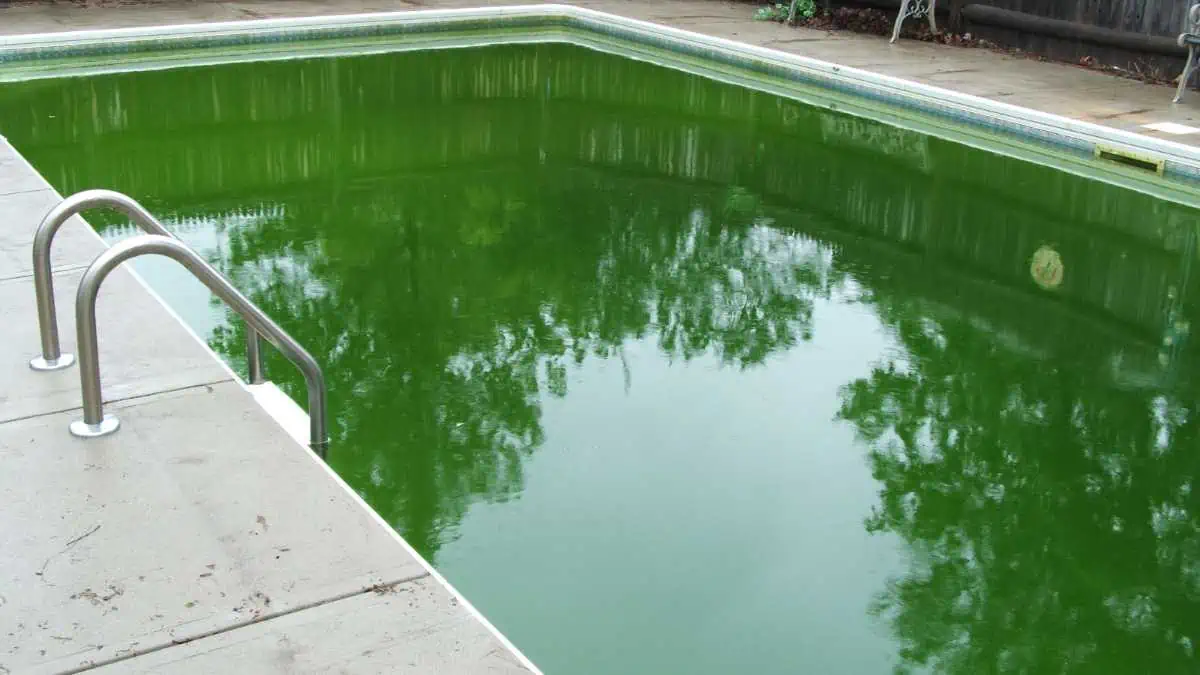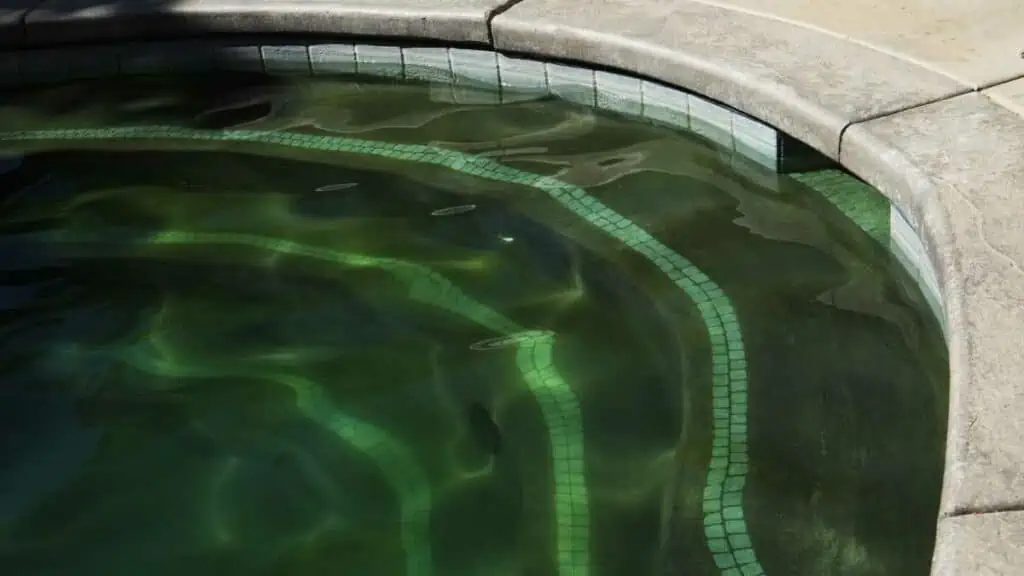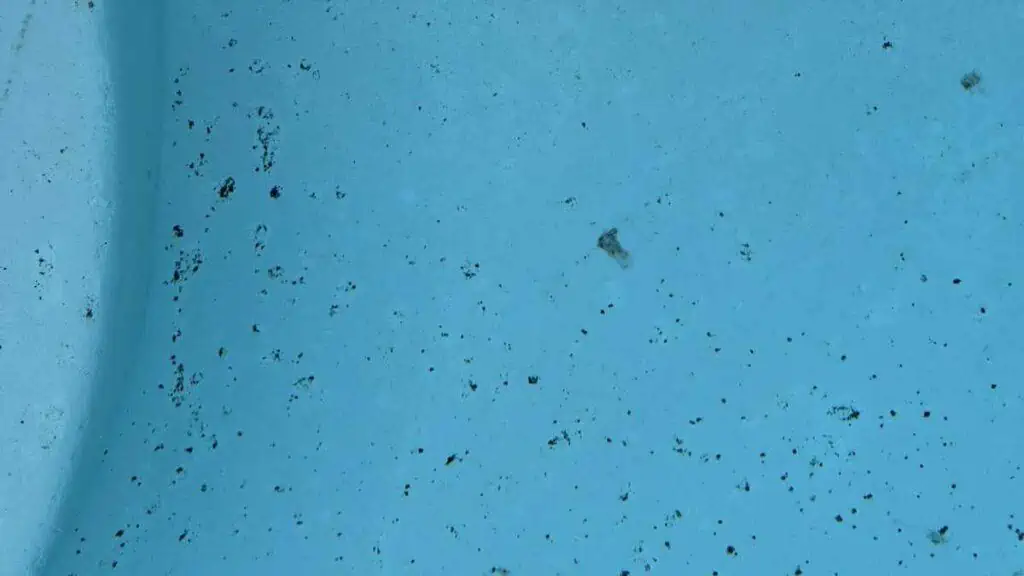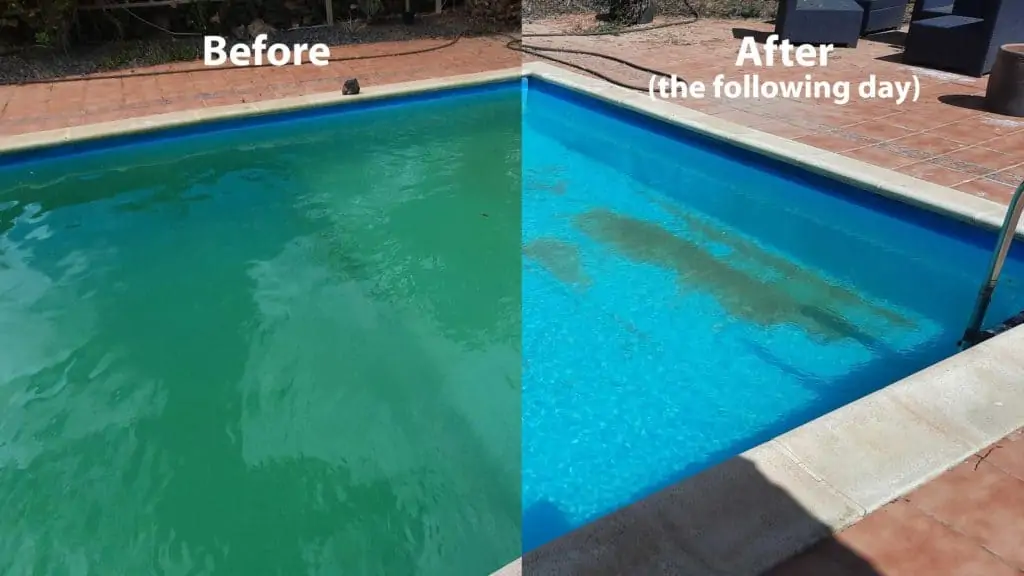As summer’s warm, golden rays beckon, the allure of a cool, refreshing dip in your pool becomes irresistible. However, the sight of murky, green-tinted water can throw a wrench into your plans.
The most common culprit? Algae!
These unwelcome guests can be more than a nuisance, transforming your crystal-clear oasis into a swampy mess. But don’t let algae spoil your summer fun.
You can reclaim your pool from these stubborn invaders with the right knowledge and tools. Whether it’s the common green algae turning your water into a verdant soup, mustard algae lurking in the shadows, or black algae clinging tenaciously to your pool walls, there’s a solution to restore your pool to its pristine, inviting condition.
In this comprehensive guide, I will dive into the world of algae, explore its different types, and provide you with practical and effective strategies to eradicate them from your pool.
Recognizing Algae Types
With over 400 species of algae that can inhabit swimming pools, it’s crucial to identify which you’re dealing with. Fortunately, you don’t need to know exactly which species you have as, broadly, they fall into three color categories: green, yellow, and black.
Green Algae

The most common type of algae, green algae, gets its name from the color it imparts to pool water. Typically floating freely, it can make the water look like a green soup or can stick to the pool’s walls and floor.
Its rapid growth rate can make your pool murky and slimy in a short period of time, ruining your swimming experience. A pool can go from clear to very green in a matter of a few hours.
Yellow Algae

Also known as mustard algae, yellow algae is a stubborn variety that clings to the pool’s walls and in corners, often in the shady parts of the pool.
What does mustard algae look like? It gives off a yellowish color but can actually be green too and can be brushed off easily, but it tends to return quickly if not treated appropriately. Despite a well-maintained pool, yellow mustard algae can still make an appearance.
Black Algae

The toughest of all algae types to eradicate is black algae in the pool. What does black algae look like? It appears as small black or blue-green spots on the pool’s surfaces, usually the size of a dime.
Its root-like structure that penetrates the pool’s surfaces and the protective outer layer that shields it from sanitizing chemicals makes it particularly stubborn. Although not as common as the other types, black algae require rigorous efforts to eliminate.
How to Get Rid of Algae in Pool
The way you treat the different types of algae is, unsurprisingly, also different. However, each method starts with increasing the chlorine levels.
I will go through the methods of killing each type of algae.
How to Get Rid of Green Algae in Pool
Green algae are typically visible in the water, giving it a green color and looking like pea soup.
If your pool water appears cloudy, it might be an early sign of green algae infestation. To prevent this, treat your pool with a chlorine shock at the rate of one gallon or one pound of granular chlorine for every 10,000 gallons of pool water. Keep your pool pump running for up to 24 hours, which may help inhibit algae formation.
If the pool has already turned green, an algaecide, in addition to the shock treatment, will be necessary. Add the chlorine as previously described and immediately introduce one quart of “algaecide 60” per 20,000 gallons of pool water. Keep the pump running for 24 hours and then re-check the chlorine levels.
If necessary, add more chlorine and keep the pump running. Ensure that the filter pressure remains within the normal range. For instance, if the initial clean pressure of your filter is 10 lbs., clean the filter when it rises 8-10 lbs. above that.
Sometimes, brushing the pool might be necessary if you observe algae accumulating on the pool’s walls and floor. Algae that attach to the walls form a protective layer, which makes it difficult to eliminate without brushing. I use “algaecide 60” for green algae, which can be found in any pool store or online.
If the steps have been effective, but the algae persist, repeat the steps as necessary. At this point, you might opt to increase the amount of chlorine per 10,000 gallons of water to two gallons of liquid chlorine.
However, be cautious not to over-chlorinate as it can bleach colored plaster and potentially damage vinyl pools. Sometimes, extra chlorine is necessary to eradicate stubborn algae. Don’t forget the algaecide – it’s a crucial component for success.

Once you have killed the algae you will be left with fine algae dust on the bottom of your pool. You will probably need to vacuum to waste to remove the algae dust.
How to Get Rid of Mustard Algae in Pool
Mustard algae, recognized by their yellow/green color, can still appear in well-maintained pools. These algae are typically found clinging to the walls, corners, or rocks, often starting on the shadier side of the pool.
Despite shocking your pool with chlorine and brushing it thoroughly, these algae can reappear in one to two weeks without the aid of a potent algaecide. Regular inspections during spring and summer can help detect and eliminate mustard algae in the pool early.
Use the same “algaecide 60” as mentioned for green algae. If mustard algae returns, repeat the shock and brushing process, then apply a “copper” algaecide, following the product’s instructions. However, use this sparingly to avoid copper sulfate stains on the pool’s surfaces.
If I ever have a problem with algae, I tend to get this type. Removing the algae from the walls etc is essential to be able to kill them effectively with the method above. This can be done by using a good pool brush, although I have found using a pressure washer to be quite effective as I push the pressure washer’s nozzle into the water.
Once you have killed the algae you will be left with fine dead algae on the bottom of your pool. You will probably need to vacuum to waste to remove the algae dust.
How to Get Rid of Black Algae in Pool
Black algae manifest as small spots on the pool’s walls or bottom. They can embed themselves in rough areas of your pool surface, rocks, or grout. Black algae develop a protective layer over their roots, which needs to be removed before the algae can be eradicated.
A small metal brush can be used to scrape off the protective layer, exposing the roots to the chlorine and algaecide in the water.
- Scrape off all the black algae in the pool.
- Increase chlorine levels to a minimum of 5 ppm.
- Introduce “black algae killer” or “copper” algaecide to the pool water, following the recommended dosage on the algaecide container.
- Keep the pool pump running for 24 hours.
- Continue to brush all black algae spots daily for about a week with a stainless steel brush.
If black algae frequently appear in your pool, it could indicate that chlorine levels aren’t maintained between 1-5 ppm. Black algae typically won’t form if there is sufficient chlorine in the pool.
Another reason could be a rough pool surface that needs resurfacing. Ensure that you keep brushing the spots until the algae is completely gone.
My recommended black algae killer is Applied Biochemists 406303A Black Algaetrine, which is available on Amazon.
You can choose to repeat the steps above to kill the black algae further but be careful not to use too much black algae killer or copper algaecide over time. Excessive copper can stain the pool with a turquoise color, which is hard to remove.
Typically, using a small amount of copper algaecide twice a year shouldn’t cause any issues.
Alternative Algaecides
There are mineral purifiers available that can prevent and kill any algae you might encounter during summer. These products are installed at the beginning of summer and provide protection all season long. Regular algaecides are typically not added until an issue arises, with the exception of maintenance doses.
Mineral purifiers work by using heavy metals such as copper or silver to kill algae and bacteria. These minerals work faster than chlorine, and most systems claim you can reduce chlorine use by 50% because you now essentially have two sanitizers in your pool.
Some of the available brands and the way they are used include:
Pool Rx
Pool RX has become very popular with many members in pool maintenance groups. This mineral purifier is easily installed by placing it into the skimmer or pump basket. It uses mostly copper to keep algae at bay and also includes a sequestering agent to help prevent copper-induced stains.
It is available at pool stores or from Amazon in various sizes, depending on pool size. Pool RX on Amazon.
Nature 2
The Nature 2 system uses a combination of copper and silver minerals to combat both algae and bacteria. This canister system can be easily installed in-line by the homeowner. The Nature 2 unit plus replacement cartridges can be purchased on Amazon.
Remember, every pool’s needs might be different, and what works for one may not work for another. It’s always important to monitor your pool regularly and adjust your maintenance routine as necessary.










Leave a Reply